Posted by Anita on 08.29.08 11:48 AM
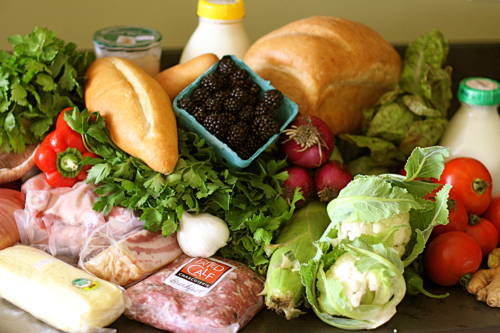
Our weekly shopping haul; One Local Summer, Week 13
—–
Unless you’ve been in a self-imposed media blackout, you may have heard about the party that Alice, Carlo, and friends are throwing here in Our Fair City. And you’d probably guess that a pair of diehard food dorks like us would be camped out in line, waiting for the chance to storm the gates first thing in the morning, wandering through the Victory Garden as we sample a continent’s worth of canapes in the dappled summer sun.
But the fact is, we live a Slow Food Nation life all the time. We spend practically every weekend grazing around the City and around the Bay Area. We live in a community where our oddball food choices have become fairly mainstream. We hang out with a crowd of thoughtful food-worshippers who can carry on a spirited debate about how to balance being a locavore with being a (small-c) chowhound.
We’re truly blessed to make our home here in the epicenter of the local, organic, sustainable food movement. San Francisco’s a city where it’s hardly a challenge at all to eat well and eat ethically… so much so that I get fairly bent out of shape when circumstances or travel force me to do otherwise.
So, no — No “Foodstock” for us. Happily, we have a lot to do this weekend:
– Buying our weekly groceries from the people who grow/make them
We do this every week at the Ferry Plaza Farmers Market, but just to make it interesting — and to bypass the frenzy of out-of-town foodies descending there this weekend — we’re heading across the bay to the Berkeley Farmers Market. We’ll see some of our usual vendors there, but I’m looking forward to exploring new stalls and new ingredients.
– Putting up food to preserve the harvest
Later in the day, we’ll pick up 100 pounds of San Marzano tomatoes at Mariquita Farm’s “guerilla veggie” drop-off. Later in the weekend, we’ll be hauling out the pressure canners and turning them into puree, marinara sauce, and whole canned tomatoes to feed us through the winter
– Supporting restaurants that support local farms
Mariquita’s making their drop at Piccino, so we’ll have a chance to experience their brunch for the first time. The fact that Sher and Wayne — like so many other San Francisco restaurateurs — procure so much of their raw ingredients from the same farmers and artisans that we buy from makes me inexplicably giddy.
– Exploring the food traditions of our neighbors
Saturday night, we’re heading out to a family-run ethnic restaurant with a group of food-obsessed friends. Later in the weekend — if we get our canning done — we’ll visit a Thai food festival put on by the local Buddhist temple at Golden Gate Park. Neither of these experiences are Slow, in the sense of using exclusively sustainable/local/organic ingredients, but supporting ethnic foodways is an essential part of being a citizen of our city and the world.
– Celebrating the bounty of our region
On Monday, we’re having some friends over for a little nosh. We’ll eat some pâté and peaches, sharp cheese and homemade plum chutney. We’ll drink local bubbly, sip homemade pear brandy, maybe even shake up a cocktail using artisanal spirits. Later there’ll be farmers-market pasta tossed with some of the marinara sauce we made earlier, maybe baguette slices spread with pesto. A pie, perhaps… made with a local-flour-and-butter crust (learned from a friend who also happens to be a local treasure) and filled with yet more amazing farmers market finds.
—-
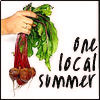 Am I conflicted about opting out of the Slow festivities? Absolutely. I’m already drooling over the Slow on the Go and Taste Pavilion tidbits showing up in friends’ Flickr streams. By all accounts, the Friday events have been beautiful, interesting, and delicious. I hope that they keep it up, because the people who’ve traveled here from all over the world deserve it. And so do the farmers, food-makers, and volunteers who are going all-out to make a fabulous impression.
Am I conflicted about opting out of the Slow festivities? Absolutely. I’m already drooling over the Slow on the Go and Taste Pavilion tidbits showing up in friends’ Flickr streams. By all accounts, the Friday events have been beautiful, interesting, and delicious. I hope that they keep it up, because the people who’ve traveled here from all over the world deserve it. And so do the farmers, food-makers, and volunteers who are going all-out to make a fabulous impression.
But on the other hand, I know we’ll make the perfect slow celebration, in all the ways that matter most to us, just as the folks visiting our city and our local producers will have theirs. Either way, I can’t think of a better way to celebrate Labor Day than by honoring the backbreaking effort — both physical and political — that our farmers and artisans spend to put quality food on our tables.
Bay Area, farmers markets, locavore, One Local Summer
18 Comments »




Posted by Anita on 08.24.08 6:08 PM
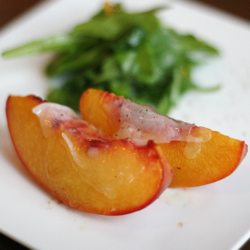 Aside from grinding and stuffing a few pounds of sausage now and then, curing meats is a task — much like beer-brewing and bread-baking — that I am more than happy to leave to the experts. Don’t get me wrong: I love getting up to my elbows in fatty meat and curing salts and aromatics. But when you have local artisans like Fatted Calf, even the most enviable meat-curing skills become obsolete.
Aside from grinding and stuffing a few pounds of sausage now and then, curing meats is a task — much like beer-brewing and bread-baking — that I am more than happy to leave to the experts. Don’t get me wrong: I love getting up to my elbows in fatty meat and curing salts and aromatics. But when you have local artisans like Fatted Calf, even the most enviable meat-curing skills become obsolete.
To say we’re big fans of the work that Taylor Boetticher, Toponia Miller, and the rest of the Fatted Calf crew are doing is a huge understatement. We’ve spent the last two years gleefully eating our way through their entire offering, and there’s barely a thing we’ve tried that didn’t make us squeal with delight. Their smoky bacon is heaven in a frying pan, their rind-on pancetta is nothing short of funky-fabulous. Their beef jerky is addictively awesome, and their pâtés and terrines are a slice of savory joy. Their sausages — especially the Toulouse and the andouille — are light-years better than anything we make at home.
So when we heard that Piccino — a jewelbox cafe/restaurant in Dogpatch, the next neighborhood over — was hosting a supper featuring Fatted Calf products, cooked jointly by Taylor and the Piccino crew, we reserved two slots as fast as our little fingers could email the RSVP.
I should add at this point that Cameron and I have mostly given up on these sorts of one-night foodie extravaganzas. It’s too easy to get your expectations set impossibly high, or to calibrate each bite to the fantastic sum of money you’ve spent. We went against our usual stance this week for two reasons: Piccino is precisely the kind of restaurant we love — a cozy neighborhood space with a short, ingredient-driven menu that actively supports local farmers and food artisans — and because we can’t get enough of Fatted Calf.
On the night of the meaty meal, we gathered on the sidewalks in front of Piccino’s corner doorway. Happy gaggles of diners shunned the interior and spread down each street, glasses of deep-pink rosé in hand as we savored a rare, warm San Francisco summer evening. We hung back for another reason, too: We weren’t sure how we would all fit into the small dining area. Eventually, we were called to the communal table, so we squeezed onto the banquette, tried not to knock elbows with our neighbors, and wondered just what we’d gotten ourselves into.
We needn’t have worried. By the time the second course (and third glass of wine) rolled around, we’d been utterly, completely won over. There were some service mishaps — one end of the table missed out on a pizza that somehow got misdelivered not once but three times — but these were forgivable, almost-funny oversights. We were chatting with our neighbors quite amiably by this point, companionably sharing platters of assorted charcuterie and a casuela full of lightly pickled, jewel-like vegetables.
 For the next course, we each got our own plates… a wise move, as I suspect that riots might have broken out otherwise. Who could be trusted to share a perfectly ripe Hamada Farms peach, draped with tissue-thin lardo, accessorized with a bitter-crisp salad of baby dandelion greens? (Hint: Not me.) Next up came an inspired riff on pork and beans: Shelling beans cooked to a toothsome creaminess, garnished with crisp-chewy pork rillons and melted Early Girl tomatoes.
For the next course, we each got our own plates… a wise move, as I suspect that riots might have broken out otherwise. Who could be trusted to share a perfectly ripe Hamada Farms peach, draped with tissue-thin lardo, accessorized with a bitter-crisp salad of baby dandelion greens? (Hint: Not me.) Next up came an inspired riff on pork and beans: Shelling beans cooked to a toothsome creaminess, garnished with crisp-chewy pork rillons and melted Early Girl tomatoes.
Then, the main course platters filled the table: unctuous smoked lamb; bowls of fregola with charred young onions and baby potatoes; marinated eggplant with roasted gypsy peppers and capers; golden beets with their own sauteed greens, tarragon, and ricotta salata; and an out-of-this-world mint chutney. After hours of joyful din, passed platters, copiously refilled glasses, and a bevvy of spontaneous toasts to the kitchen, we were struck dumb. Everyone, all down the table, sat nearly silent, in awe of the fabulous food.
We hardly had room for dessert, but we bravely soldiered on. Plates of figs in various stages of caramelization arrived, dolloped with sheep’s milk fromage blanc, decorated with strawberries, and accompanied by an almond tuile. We lingered in the candlelight, talking with new acquaintances and exchanging plans to run into one another at the market next weekend. When I looked at my watch, I was stunned to see it was nearly midnight: We’d passed 5 hours in a magical space that somehow seemed to have grown larger, filled with conversation, light, and laughter.
To me, the most amazing thing about the whole meal was that (with the exception of the fregola and the wines) everything we ate came from within our local foodshed. The lamb was grown on the same Napa homestead as the shelling beans, both brought to Taylor as part of an over-the-fence trade with a prolific neighbor. Like all of Piccino’s regular meals, the vegetables and fruits for the evening were sourced from local farmers; many of their names graced the menu.
Although this was a one-time event, we’re already looking forward to going back to Piccino often. (I’ve stopped in a few times for a glass of wine and a bite to eat after picking up my Mariquita mystery box, but I haven’t really tried a whole meal there. That’s going to change.) And, if you’re in the mood for an epic food evening like ours, check out the Piccino schedule; there’s another meat dinner scheduled with RoliRoti’s Thomas Odermatt in October, and a mushroom feast with Far West Fungi in November.
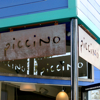
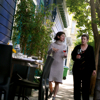
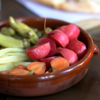
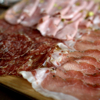

Piccino Café and Pizzeria
801 22nd Street
San Francisco, CA 94107
415/824-4224
Fatted Calf Charcuterie
Oxbow Public Market
644-C First Street
Napa, CA 94559
707/256-3684
– Also sells most products at:
Berkeley Farmer’s Market
Saturday, 10 to 3
Ferry Plaza Farmer’s Market
Saturday, 7:30 to 2
locavore, meat, Napa & Sonoma, One Local Summer, restaurants
10 Comments »




Posted by Anita on 08.20.08 5:35 PM
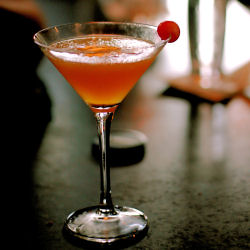 As our book club sips its merry way around the City, we’re discovering quite a few cocktails that we really like. Try as we might to work up enthusiasm for the drinks we’ve intended to sample, more often than not we actually become quite captivated by another option on the menu.
As our book club sips its merry way around the City, we’re discovering quite a few cocktails that we really like. Try as we might to work up enthusiasm for the drinks we’ve intended to sample, more often than not we actually become quite captivated by another option on the menu.
Such was life the other night at the bar at Range, where we’d gone to sample the Green Lantern, their contribution to Food & Wine Cocktails 2008. It’s an interesting enough drink, and if you hadn’t told me the lurid green came from muddled kiwifruit, I probably would have been stumped.
But the highlight of the evening was two pleasant surprises behind the bar: A newly-shorn Carlos Yturria — who, much to everyone’s pleasure has taken the Wednesday shift alongside the ever-fabulous Brooke — and the reappearance of a summertime favorite on the drinks list. The stalwart known as the Sungold Zinger has graced Range’s warm-weather cocktail menu since the restaurant’s earliest days, and its fan club is legion.
Jen ordered one, served by the man who invented it. Then Fatemeh followed, and then me, and then Cameron, and pretty soon there was a line down the bar of these sharp-looking, vibrant-orange cocktails. Well-balanced, tangy but not too tart, it’s a simple but beguiling combination… the kind of drink you wonder why nobody invented before. Everyone who tasted it had to have one of their own; we were totally smitten. And, apparently, we’re not alone: the Sungold Zinger was chosen one of the 20 best cocktails in America by GQ magazine.
It’s a simple enough recipe to make at home, especially when Sungold tomatoes are at their peak, as they are right now. But if you’re anywhere near Range — especially on a Wednesday night when Carlos is around — drop in for a little sip of summer sunshine.
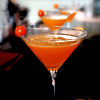


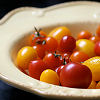
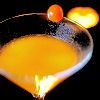
Sungold Zinger
3-4 Sungold tomatoes
Pinch of sea salt
1/2 oz agave syrup
1/2 oz lemon juice
1-1/2 oz 209 gin
Muddle the tomatoes, salt, and syrup together in a mixing glass. Add lemon juice and gin, and shake well with ice. Strain into a chilled cocktail glass, and garnish with another tomato on the rim.
Variation: Replace the agave syrup with an equal amount of St-Germain elderflower liqueur, a nice alternative if you want a little floral hit.
(leftmost filmstrip photo courtesy of book-club member *fatemeh* via CreativeCommons)
bar culture, Drink of the Week, drinks, recipes, restaurants, The Mission
14 Comments »




Posted by Anita on 08.17.08 4:00 PM
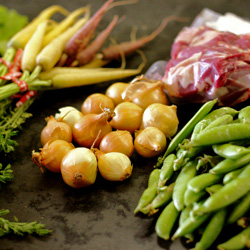 Compared with other parts of the country, most of the Bay Area’s food-growing regions benefit from amazingly temperate climates. Our summers here are so mild that we never really lose our early crops. We’re able to buy all those little springtime dainties — sugar-snap peas, baby carrots, and tiny onions — deep into August.
Compared with other parts of the country, most of the Bay Area’s food-growing regions benefit from amazingly temperate climates. Our summers here are so mild that we never really lose our early crops. We’re able to buy all those little springtime dainties — sugar-snap peas, baby carrots, and tiny onions — deep into August.
It’s a little joke of nature, of course, because the summer months in San Francisco feel like the worst parts of everyone else’s schizophrenic spring. You know that “in like a lion, out like a lamb” effect that people ascribe to March? Well, here we get it all in a single August weekend. Repeatedly.
For every warm and sunny Sunday where all you want is a summer supper of insalata caprese and a nibble of grilled chicken, there are twice as many foggy, grey Saturdays where something a little more substantial is in order. Not that we’re hauling out the cassoulet or anything, but our summertime cold snaps are so inevitable that we almost always plan a stew or braise each week, to haul out when the fog rolls in.
But even when the mercury dips down into the 40s, I have a hard time getting behind ultra-heavy dinners. The nights are still short, after all, and we’ve probably had at least a glimpse of sun during the day. So I prefer a compromise; a stew that’s almost spring-like, with a lighter air about it.
In France, you’d probably serve a lighter braise like the one we made this week in springtime, with a glass of rosé and a loaf of crusty bread. But, socked in by fog so dense we could barely see the neighbors’ yard, we opted for a pile of mashed heirloom potatoes and a half-bottle of local Syrah.
The good news is that the best is yet to come: The true beauty of San Francisco weather is our Indian Summer. When the rest of the world is gearing up for deep autumn, our farmers will still be pulling in corn, tomatoes, and all the other high-summer crops. But for now, while we slip on our sweaters, a stew will do.
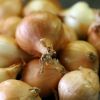
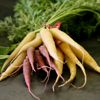
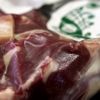


Navarin Printanier — Braised Lamb with Young Vegetables
1 large thyme sprig
1 rosemary sprig
1 bay leaf
6 whole black peppercorns
2 pounds lamb stew meat
olive oil
1 small onion, small dice
3 cloves garlic, minced
1 cup dry white wine
2 cups beef stock
12 pearl onions
1/2 lb baby carrots, trimmed and scrubbed
1/2 lb sugar snap peas, trimmed
2 T unsalted butter (room temperature)
3 T all-purpose flour
Preheat oven to 300°F. Put the rosemary, thyme, bay leaf, and peppercorns in an infusing ball, or tie into a square of cheesecloth.
 Trim the stew meat of all excess fat, and cut into 2-inch pieces; season with salt and pepper. In a 4-quart pot, heat enough olive oil to coat the bottom of the pan, and brown meat in as many batches as needed to keep from crowding the pan. As each piece becomes well browned, remove it to a bowl with tongs or a slotted spoon. Continue with remaining meat, adding more oil as needed.
Trim the stew meat of all excess fat, and cut into 2-inch pieces; season with salt and pepper. In a 4-quart pot, heat enough olive oil to coat the bottom of the pan, and brown meat in as many batches as needed to keep from crowding the pan. As each piece becomes well browned, remove it to a bowl with tongs or a slotted spoon. Continue with remaining meat, adding more oil as needed.
After all meat is cooked and resting, add onions to the pan. Cook over medium heat until softened and beginning to color. Add minced garlic and continue to cook until onions are golden. Add the wine and the stock, scraping the bottom of the pan to loosen any browned bits. Return the meat and its juices to the pan, along with the herb ball. Bring to a simmer on the stovetop, then cover and put in the preheated oven for 60 to 90 minutes.
While meat is braising, prep the vegetables. Place a large bowl two-thirds full of ice and water near the stove. Bring a large pot of salted water to a boil, and cook the unpeeled pearl onions until tender; timing will vary greatly depending on size and freshness of your onions. When tender, remove with a slotted spoon to the ice-water bath to cool, reserving the boiling water. Parcook the peas next, and remove to the ice-water bath when cooked through but still bright and snappy. Finally, parcook and chill the baby carrots. When all vegetables are cooked, drain them in a colander. Peel the onions, being careful not to remove too much of the root, and set aside with the rest of the vegetables until lamb is cooked.
When the meat is just tender but not falling apart, return the pan to the stove over medium-low heat. Adjust seasonings with salt and pepper, then scoot the meat to one side of the pan. Stir together the butter and flour to make a paste, and add it, bit by bit, to the simmering braising liquid to thicken the juices to a gravy-like consistency; you may not need all of the paste. When you get the thickness you like, stir the meat back into the sauce and simmer for another 2 minutes to allow the flour to cook out. Add the vegetables to the pan, and cook just until heated through. Adjust again for salt and pepper, and serve.
locavore, meat, One Local Summer, recipes
5 Comments »




Posted by Anita on 08.17.08 12:20 PM
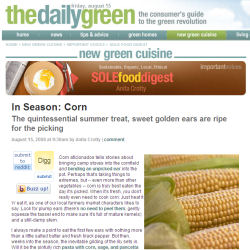 I mentioned this a few months ago, but — since it took a while to get rolling, and then a little longer to get things dialed in — I thought it might be nice to revisit my other blog-home, The Daily Green. My mini-column, SOLE Food Digest (Sustainable, Organic, Local, Ethical) recaps the good-news side of eating with a conscience, including seasonal suggestions and other encouraging tips from the blogosphere and beyond. It runs three times a week, and you can add it to your reader by subscribing to the SOLE feed.
I mentioned this a few months ago, but — since it took a while to get rolling, and then a little longer to get things dialed in — I thought it might be nice to revisit my other blog-home, The Daily Green. My mini-column, SOLE Food Digest (Sustainable, Organic, Local, Ethical) recaps the good-news side of eating with a conscience, including seasonal suggestions and other encouraging tips from the blogosphere and beyond. It runs three times a week, and you can add it to your reader by subscribing to the SOLE feed.
If you want to read all Daily Green food bloggers’ posts — including “What to Eat” from Marion Nestle, “Recipes from the Gluten-Free Girl” by Shauna Ahern, and “100-Mile Diet” updates from Alisa Smith and James MacKinnon, then subscribe to the feed for New Green Cuisine.
Back on the home front, if you’ve been clamoring for a way to keep on top of Married …with Dinner — and you’re not using an RSS reader, for whatever reason — you can now subscribe via email.
And if you’re waiting on a comment response from me… mea culpa. It’s been a doozy of a week here, and I will try my best to write coherent follow-ups soon.
other blogs, other stuff
Comments Off on Here and there




Posted by Anita on 08.11.08 12:07 PM
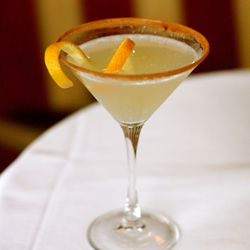 The Bay Area is home to so many fabulous local spirits that it seems almost impossible to single any of them out for special attention. For gin alone, we’ve got 209 and Junipero right here in the City, and Sarticious over the hill in Santa Cruz. We’re close to two top-tier artisan vodka companies — Charbay in Napa and Hangar One on Alameda — both of which also make a variety of other liquors and liqueurs, including St. George Absinthe and Single-Malt Whiskey, and Charbay Rum and Pastis. We’ve got a local brandy-maker, an old-school whiskey distiller, and even a bierschnapps haus.
The Bay Area is home to so many fabulous local spirits that it seems almost impossible to single any of them out for special attention. For gin alone, we’ve got 209 and Junipero right here in the City, and Sarticious over the hill in Santa Cruz. We’re close to two top-tier artisan vodka companies — Charbay in Napa and Hangar One on Alameda — both of which also make a variety of other liquors and liqueurs, including St. George Absinthe and Single-Malt Whiskey, and Charbay Rum and Pastis. We’ve got a local brandy-maker, an old-school whiskey distiller, and even a bierschnapps haus.
But honestly, San Francisco’s best local drinking resource may be its bumper crop of creative mixologists. As Camper pointed out (and I keep harping on at every chance I get), Food & Wine Cocktails 2008 includes an unmatched 17 recipes from SF’s watering holes. The bartenders in our City aren’t just great at mixing up other peoples’ recipes, they’re tops at creating new drinks, too.
San Francisco’s bragging rights as a cocktail-creation mecca can be traced to an illustrious heritage, arguably starting with Jerry Thomas‘s 1880s invention of the Martinez, running through the 1920s with Duncan Nicol’s creation Pisco Punch, and Trader Vic’s Bergeron‘s (oft-disputed) introduction of the Mai Tai in 1944. And — just as today — the City’s always been full of canny restaurateurs popularizing drinks that were invented elsewhere, bringing signature drinks like Irish Coffee to the masses.
 All by way of saying: This month’s episode of Mixology Monday — Local Flavors, hosted by Kevin at Save the Drinkers — has got our name all over it.
All by way of saying: This month’s episode of Mixology Monday — Local Flavors, hosted by Kevin at Save the Drinkers — has got our name all over it.
Now, I’m generally not a fan of tampering with the classics. But here’s one exception: The Cable Car, a clever Sidecar variation with a decidedly local angle. Created by Tony Abou-Ganim in 1996, the drink became the signature cocktail at Harry Denton’s Starlight Lounge, the iconic nightclub perched at the top of the Sir Francis Drake hotel “between the stars and the cable cars”. The Starlight’s specialty drink menu leads off with the Cable Car to this day… no mean feat in a town where cocktails are forgotten before the publicity even hits the presses.
So the Cable Car’s got a good back-story, and a gorgeous home bar. But how’s it taste? Frankly, the sample we sipped last weekend was unworthy of its lofty setting, not to mention its illustrious pedigree. Captain Morgan may be the 900-pound gorilla in the spiced-rum category (not to mention a pop-culture icon), but he’s no friend of my palate. And really, a drink with its roots in France deserves a better orange liqueur than Marie Brizard. I know it gets busy at the Starlight, but I’d like to think that the cocktail world has evolved past the point where a reputable bar resorts to sour mix, even its own house-made stuff.
So let’s bring this one a little closer to today’s standards: Fresh lemon juice, quality rum, a dash of real spice, and a top-shelf orange liqueur. A true San Francisco treat.
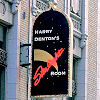
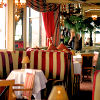


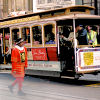
Cable Car Deluxe
– inspired by Tony Abou-Ganim‘s modern classic
1-1/2 oz gold rum (such as Appleton V/X)
scant 1/4 tsp allspice dram
3/4 oz Grand Marnier
1 oz lemon juice
1/2 oz simple syrup (highly optional)
Shake with ice, and strain into a chilled, cinnamon-sugar-rimmed cocktail glass. Garnish with an orange or lemon spiral.
———————-
Other featured cocktails with a San Francisco twist:
- Bee’s Knees – Our version, made with 100% local ingredients
- The Soiree – SF Cocktail Week’s signature drink for 2008
- Martinez – Jerry Thomas invented it here in San Francisco
Drink of the Week from our local bars:
bar culture, Bay Area, downtown SF, Drink of the Week, drinks, locavore, Mixology Monday, recipes
8 Comments »




Posted by Anita on 08.10.08 8:22 PM
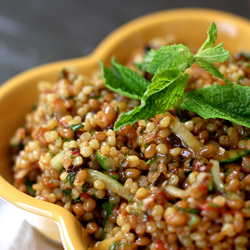 After a whirlwind month of travel, it sure feels good to be home. Even though I was painfully aware of the time we’d spent away from our own kitchen, I hadn’t really grasped how long we’d been absent from the farmers market. Despite our well-planned list, we wandered around the Ferry Plaza in a full-blown daze, like tourists who’d never seen produce before. But our farmers seemed genuinely happy to see us, and the usual summer bounty looked more glorious than ever to our newly appreciative eyes.
After a whirlwind month of travel, it sure feels good to be home. Even though I was painfully aware of the time we’d spent away from our own kitchen, I hadn’t really grasped how long we’d been absent from the farmers market. Despite our well-planned list, we wandered around the Ferry Plaza in a full-blown daze, like tourists who’d never seen produce before. But our farmers seemed genuinely happy to see us, and the usual summer bounty looked more glorious than ever to our newly appreciative eyes.
But somehow — even though we returned home with armloads of the most beautiful food on the planet — our first real meal back home didn’t translate into a fabulous feast. The occasional lackluster supper is bad enough when you’ve put an afternoon of thought and effort into it, but when you’re having company over to boot… ugh.
We turned some of our meat CSA haul into homemade sausage using Ruhlman’s merguez recipe. The test patties we made tasted fine, but an afternoon of fridge-rest made the coils taste blah, not bright. Somehow a Turkish-style soup of tepary beans and cumin — which I’ve made before and loved — turned into a stodgy mess.
For dessert, we harvested three beautiful bergamots off our tree to make champagne-citrus sorbet. But when we cut the fruits open, they were nearly all pith. Desperately squeezing them anyway while praying for a food miracle, we got less than half the juice we needed. We punted and bought a replacement carton from Whole Foods, and served it alongside locally made baklava.
But luckily, despite all the other disappointments, our side dishes turned out pretty well. On the grill alongside the mergez, we roasted skewers of multicolored sweet peppers from Quail Hollow and purple onions from Catalan. And even though it looked a bit like leftover hot cereal, a salad of Full Belly Farms wheatberries — dressed with local vegetables and our own garden herbs — was the best thing we ate all night.
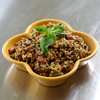
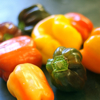
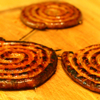
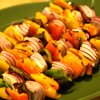

Wheatberry Salad
– adapted from Epicurious
1 cup wheatberries
1 red bell pepper
1/4 cup olive oil
2T fresh lemon juice
1T red-wine vinegar
1 tsp ground cumin
2 cloves garlic, minced
2 tsp coarsely ground aleppo pepper (or to taste)
3T minced parsley
3T mint chiffonade
2 ounces feta, diced small
1/2 cup thinly sliced red onion
1/2 English (or other seedless) cucumber, cut into julienne strips
2T to 1/4 cup chopped brine-cured black olives
 Soak the wheatberries overnight, or for at least a few hours. Cook the berries in a large pot of boiling salted water until tender but not blown out, about 2 hours. (Depending on freshness, wheat variety, and soaking time, this can take as little as an hour or up to 3 hours.) When cooked, drain the berries and set aside.
Soak the wheatberries overnight, or for at least a few hours. Cook the berries in a large pot of boiling salted water until tender but not blown out, about 2 hours. (Depending on freshness, wheat variety, and soaking time, this can take as little as an hour or up to 3 hours.) When cooked, drain the berries and set aside.
Meanwhile, roast the red pepper and place in a brown bag or covered bowl to steam soft, about 20 minutes. When cool enough to handle, remove the skin and seeds, and slice the flesh into long, narrow strips.
In a large bowl, whisk together the olive oil, lemon juice, vinegar, cumin, garlic, aleppo pepper, and salt to taste. Add the cooked wheatberries and stir well to coat; toss in the remaining ingredients. Taste for seasonings and adjust if needed. Serve immediately at room temperature. (You can also refrigerate as needed, but the salad will be stickier. Be sure to remove from the fridge about 30 minutes before serving to take off some of the chill, and toss again to refresh the appearance of the dish.)
entertaining, locavore, One Local Summer, recipes
8 Comments »




Posted by Anita on 08.04.08 8:39 PM
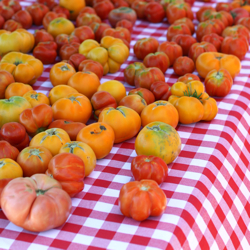 Once upon a time, Southern California was an agrarian epicenter where even small back yards usually boasted a mini-orchard, bursting with citrus or stone fruit.
Once upon a time, Southern California was an agrarian epicenter where even small back yards usually boasted a mini-orchard, bursting with citrus or stone fruit.
My father’s parents lived in semi-rural Monrovia, on a plot that included chickens, a kitchen garden, and a small avocado orchard that Dad tended to earn his allowance. Mom’s parents lived in suburban Glendale, but even their yard was full of edible options, including an enormous orange tree that we harvested for fresh-squeezed juice. As late as the 1980s, there were were actual citrus groves still supplying fruit for roadside stands near my childhood home in Orange.
But these days, urban blight and suburban sprawl have plowed under this once-fertile landscape; the names of streets and boulevards offer the last hint of the area’s pastoral past. Sadly, you’ll find no nuts on Nutwood, no oranges on Orangethorpe, no chiles in Anaheim. A few last pocket farms remain, but by and large they’re limited to mono-crops like strawberries or pumpkins… the kinds of u-pick items that scout troops and school groups will pay to see.
As you might imagine, an area this divorced from its farming heritage makes for a pretty tough locavore life. Despite a few large, well-regarded farmers markets, even the notion of a dedicated farm-to-table restaurant is pretty out on the fringe. LA Weekly–überfoodie Jonathan Gold laments that “the idea of locavore dining is more admired than actually practiced in Los Angeles, even at the restaurants where farmer-celebrities like Alex Weiser or the McGraths are treated with more awe than Matt Damon.”
For home cooks, local produce is widely available so long as your schedule and location make it easy for you to visit the bigger farmers markets in Irvine, Hollywood, or Santa Monica. But if you’re not able to shop on Saturday, you’re pretty much stuck with food of unknown origin. During our recent trip to the area, we rented a vacation house with my family for the week, and so we had access to a kitchen. But we got into town too late to hit the farmers markets… a mistake we will be sure not to repeat!
Much like the supermarkets back home in Northern California, none of those we visited in Los Angeles or Orange County offered any indication of where their food came from. Even Whole Foods was a joke: Items bottled in Napa Valley — at the other end of the state — were proudly labeled as “LOCAL!”. When we asked employees about this, they pointed out Whole Foods’ store policy: Anything raised within 7 hours of the market was considered local… perhaps the most liberal interpretation of locavorism that I can imagine. And although we’re used to having to pay close attention to sourcing even at our local Whole Foods, we were surprised that we didn’t see a single ‘local’ sign in the produce section.
But it was Henry’s Marketplace — part of the Wild Oats chain — that won the hypocrisy prize: A giant banner on the rear wall of the store read: “Choose LOCAL! Enjoy the freshest flavors from your community.” But in fact, the only local products we were able to find in the entire store were Broguiere’s milk (locally processed from semi-local, non-organic herds) and Henry’s own-brand eggs. Not a single fruit or vegetable bin was labeled with its point of origin, much less its farmer’s name.
 After much searching, we stumbled upon the website for South Coast Farms, one of Orange County’s last small-scale farm operations. We took a trek down Coast Highway to find that they do run a daily farm stand with a remarkably diverse set of offerings… our first clue that something wasn’t quite right. Turns out, only a handful of the items for sale are actually grown on site: Tomatoes, cucumbers, onions, and a few herbs. Others are ‘local’ — alas, no indication on signs of farms or even towns — and many are simply big-organic imports from South America. (Apparently, their CSA is a little more focused than the stand.)
After much searching, we stumbled upon the website for South Coast Farms, one of Orange County’s last small-scale farm operations. We took a trek down Coast Highway to find that they do run a daily farm stand with a remarkably diverse set of offerings… our first clue that something wasn’t quite right. Turns out, only a handful of the items for sale are actually grown on site: Tomatoes, cucumbers, onions, and a few herbs. Others are ‘local’ — alas, no indication on signs of farms or even towns — and many are simply big-organic imports from South America. (Apparently, their CSA is a little more focused than the stand.)
Working on a tip that Cal Poly Pomona offered local meat processed by their students, we took a trip out to the Farmstore at Kellogg Ranch. We did find local protein, but frozen chickens and a few sausages were all that the cases held. (Perhaps the stock is better during the school year?) Once again, it was anyone’s guess whether the fruits and veggies on offer were grown locally; there were a number of out-of-season crops for sale that made us suspect not. We got all excited over an entire wall of preserves, pickles, and sauces in quaint Mason jars, until we naively asked the store manager whether they were made by students, or just made from the farm’s own crops. “Oh, no…” she replied, with a tone that implied we’d just rolled off the turnip truck, “We just buy them from a company that puts our label on them.”
Defeated, we stopped into one of the smaller weekday farmers markets to see what we could cobble together. Although there couldn’t have been more than a dozen stalls, the mostly-Latino farmers offered a nice assortment of options: A basketful of tomatillos, a few heads of pungent celery, brown bags of fingerling potatoes, a huge pile of frying chiles, stacks of whiskery onions. Nobody seemed to be indulging in the luxury of specialization, which suited us just fine.
I won’t even go into the afternoon we spent trying to find local rolls for our sausages, but suffice to say we succeeded — even though we bought squishy commercial hoagie buns from the supermarket. A tiny corner store near our beach house supplied us with locally made tortilla chips, which we ate dipped in salsa verde made entirely from farmers market vegetables. For our entrees, we grilled up the German-style bratwurst we’d found at Cal Poly, topped them with a sauteed mix of peppers and onions, and served them on those supermarket buns. On the side, we had our favorite potato salad — everything locally sourced except the mayo and spices… and pickles from one of Kellogg Ranch’s faux-local canning jars.
Of course, it took us all week to get everything we needed, and our carbon footprint was enormous: We took the 100-Mile Diet to a literal extreme, racking up 90+ miles in the car on our search. I’m sure that with a little practice and a lot of hunting, we could find easier sources for much of what we drove around to find. But I’m thankful, more than ever, for the bounty that sits literally at my doorstep in San Francisco.
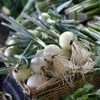
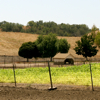
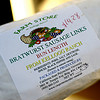
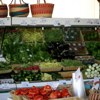
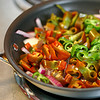
South Coast Farms
32701 Alipaz Street
San Juan Capistrano, CA 92675
(949) 661-9381
Monday through Saturday 9am to 5pm; Sundays 9am to 4pm
The Farmstore at Kellogg Ranch
4102 S. University Drive
Pomona, CA 91768
(909) 869-4906
Sunday through Friday 10am to 6pm; Saturday 8am to 6pm
Tustin Farmers Market
Corner of El Camino Real and 3rd Street
Tuesdays, 9am to 1pm
locavore, One Local Summer, SoCal
16 Comments »




 Am I conflicted about opting out of the Slow festivities? Absolutely. I’m already drooling over the Slow on the Go and Taste Pavilion tidbits showing up in friends’ Flickr streams. By all accounts, the Friday events have been beautiful, interesting, and delicious. I hope that they keep it up, because the people who’ve traveled here from all over the world deserve it. And so do the farmers, food-makers, and volunteers who are going all-out to make a fabulous impression.
Am I conflicted about opting out of the Slow festivities? Absolutely. I’m already drooling over the Slow on the Go and Taste Pavilion tidbits showing up in friends’ Flickr streams. By all accounts, the Friday events have been beautiful, interesting, and delicious. I hope that they keep it up, because the people who’ve traveled here from all over the world deserve it. And so do the farmers, food-makers, and volunteers who are going all-out to make a fabulous impression.









































